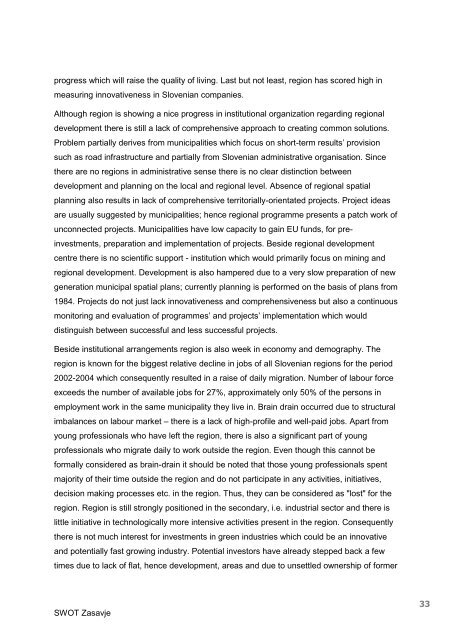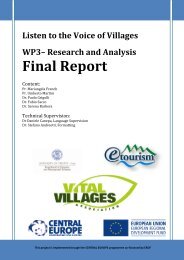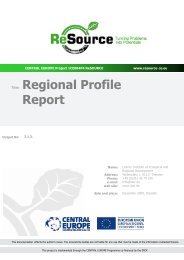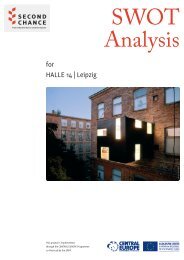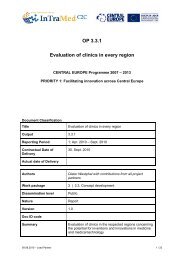SWOT Report I - Central Europe
SWOT Report I - Central Europe
SWOT Report I - Central Europe
Create successful ePaper yourself
Turn your PDF publications into a flip-book with our unique Google optimized e-Paper software.
progress which will raise the quality of living. Last but not least, region has scored high in<br />
measuring innovativeness in Slovenian companies.<br />
Although region is showing a nice progress in institutional organization regarding regional<br />
development there is still a lack of comprehensive approach to creating common solutions.<br />
Problem partially derives from municipalities which focus on short-term results’ provision<br />
such as road infrastructure and partially from Slovenian administrative organisation. Since<br />
there are no regions in administrative sense there is no clear distinction between<br />
development and planning on the local and regional level. Absence of regional spatial<br />
planning also results in lack of comprehensive territorially-orientated projects. Project ideas<br />
are usually suggested by municipalities; hence regional programme presents a patch work of<br />
unconnected projects. Municipalities have low capacity to gain EU funds, for pre-<br />
investments, preparation and implementation of projects. Beside regional development<br />
centre there is no scientific support - institution which would primarily focus on mining and<br />
regional development. Development is also hampered due to a very slow preparation of new<br />
generation municipal spatial plans; currently planning is performed on the basis of plans from<br />
1984. Projects do not just lack innovativeness and comprehensiveness but also a continuous<br />
monitoring and evaluation of programmes’ and projects’ implementation which would<br />
distinguish between successful and less successful projects.<br />
Beside institutional arrangements region is also week in economy and demography. The<br />
region is known for the biggest relative decline in jobs of all Slovenian regions for the period<br />
2002-2004 which consequently resulted in a raise of daily migration. Number of labour force<br />
exceeds the number of available jobs for 27%, approximately only 50% of the persons in<br />
employment work in the same municipality they live in. Brain drain occurred due to structural<br />
imbalances on labour market – there is a lack of high-profile and well-paid jobs. Apart from<br />
young professionals who have left the region, there is also a significant part of young<br />
professionals who migrate daily to work outside the region. Even though this cannot be<br />
formally considered as brain-drain it should be noted that those young professionals spent<br />
majority of their time outside the region and do not participate in any activities, initiatives,<br />
decision making processes etc. in the region. Thus, they can be considered as "lost" for the<br />
region. Region is still strongly positioned in the secondary, i.e. industrial sector and there is<br />
little initiative in technologically more intensive activities present in the region. Consequently<br />
there is not much interest for investments in green industries which could be an innovative<br />
and potentially fast growing industry. Potential investors have already stepped back a few<br />
times due to lack of flat, hence development, areas and due to unsettled ownership of former<br />
<strong>SWOT</strong> Zasavje<br />
33


